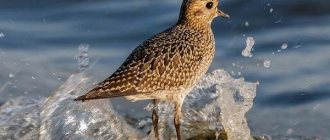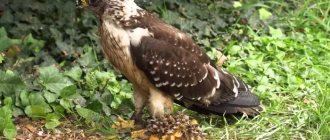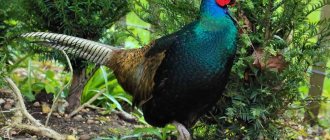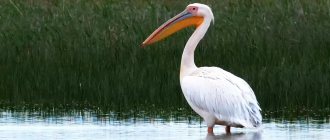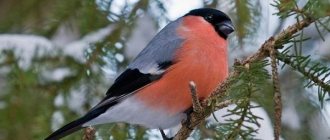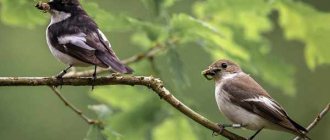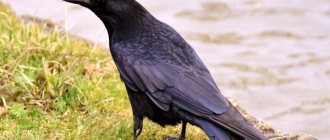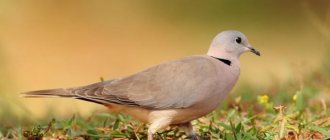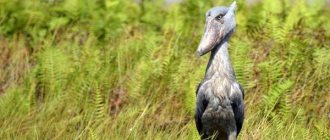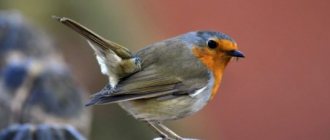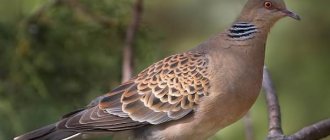- Wild animals
- >>
- Birds
Such an unusual bird as the woodcock was often mentioned in various works of art. One has only to remember “Notes of a Hunter” by I.S. Turgenev. Woodcock has quite beautiful and patterned plumage, especially on the wings. We will try to analyze everything related to the life activity of this bird, from the history of its origin to the size of the bird population.
Description and characteristics of the genus
The genus of woodcock birds is represented by a small number of species, which will be discussed later. All of these species, however, are similar and have many common features. Therefore, let's start with a description of the entire genus of birds.
Woodcock bird in flight
Such birds are quite large inhabitants of their environment. They reach a height of 40 cm and a body weight of 400-500 grams. They are also characterized by a considerable wingspan, capable of reaching 50-60 cm in length.
The color of the birds differs slightly from the color of the plumage of other members of the family. Thus, woodcocks are very reminiscent of their close relatives - snipe, godwit and sandpiper.
Their feathers, as a rule, are light brown or gray in color, and on top they are covered with numerous black spots. Moreover, the lower part of the bird’s body is covered with black stripes. Thus, the bird becomes less noticeable among the dense foliage of the trees.
The most important feature of this genus is the long and thin beak of the birds. Its maximum length is 10 cm. It, first of all, helps birds get food and take care of their offspring.
Common woodcock
In addition to their unique beak, woodcocks have excellent vision: their eyes are located on the sides of their small heads, increasing their vision to almost 360 degrees. Therefore, during flight and rest, these birds have almost the same orientation in space as owls, who are able to survey their surroundings with the help of a very flexible neck.
Interesting Facts
- Woodcocks can see 360 degrees.
- These birds are mentioned in many literary works, for example, by such writers as Turgenev and Dahl.
- Under normal conditions, woodcock does not chirp or sing. Only during the mating season, to attract a female, males make sounds similar to hoarse screams.
- What is woodcock anyway? This word comes from the German language and means “wood sandpiper.”
- Woodcocks are polygamous.
- Birds can navigate well in the dark.
- Most woodcocks exhibit philopatry. This is a phenomenon in which birds, when migrating, return to the place where they were born.
- The lifespan of birds is about ten years.
- Keeping a woodcock in captivity is very problematic; it must eat about 200 g of protein. In addition, they practically do not take root, and it is very difficult to buy one.
Woodcock species
There are eight separate species in the genus of these birds, sometimes called royal birds. The first and most common of them is the common woodcock, which does not differ from its “brothers” in anything special. It is he who is a classic example of his genus and has medium size and “classic” plumage. We will look at other equally famous species - American, Amami and Oakland Woodcock.
American look
Representatives of this species received this name due to their habitat. These birds are distributed mainly in North America. Individuals of this species are distinguished by their small sizes and rather “rounded” body shapes. They are quite low and squat. Due to the very short legs and rounded shape of the body, it seems that these birds do not walk on the ground at all, but simply roll over it.
American woodcock
The body length of such birds is only 25-32 cm, and their body weight is no more than 210 grams. The bird's plumage and its "squatness" help it easily camouflage itself and avoid being seen by predators. On the body of American birds you can see only 4-5 dark stripes, since they are small enough for a three-dimensional pattern.
The plumage of representatives of this species is practically no different from other birds of the woodcock genus. It has a light brown, gray or occasionally golden color. The American species is one of the most valuable hunting objects among other woodcocks.
Amamiyan
The Amami species is very different from the American species in appearance. He has a fairly slender and toned body with strong and clearly visible legs. Particularly noteworthy are the long and tenacious fingers of the Amamians, which help them take off and land.
Amami woodcock
The “growth” of birds of this species is small, although it exceeds the value of the American species - 34-37 cm. The plumage of birds takes on a brownish-olive color, and there are even dark red patterns on the upper part of the body. A characteristic feature of the Amamians are small “rings” of pale pink skin around both eyes. However, when looking at the bird they are extremely difficult to notice.
The distribution areas of the Amami species are limited. Such birds live in the Asian part of our planet, exclusively on islands in the East China Sea. For this reason, this species is protected.
Auckland
The distribution range of representatives of this species is also extremely limited. They live only on some islands of New Zealand (primarily the Auckland Islands), and therefore have acquired features that are unique to woodcocks.
It is noteworthy that many scientists do not even classify these birds as woodcocks. They are usually classified as a genus of birds very similar to woodcocks - the snipe genus. However, the similarity of these birds with individuals of the royal genus was found to be very pronounced, and therefore they began to classify it as a member of the genus we are considering. So what are these similarities?
Auckland woodcock
First of all, it is worth saying that the color of the feathers of the Auckland snipe is exactly the same as that of the royal birds. They have light brown plumage with numerous spots. The size of the “Auckland” is somewhat smaller than that of other species. Their average body weight is only 100-120 grams, and the length of their wingspan does not exceed 10-11 cm.
However, the most important feature of the “Auckland” is precisely their way of life, which almost completely coincides with woodcocks. They nest on the ground, obtain food using nerve endings on their beaks, and lead a secretive, nocturnal lifestyle, which is not at all typical for other representatives of their genus. Therefore, classifying these birds as a different genus is quite justified.
The only difference in lifestyle is that representatives of the Auckland species lay only 2 eggs during the breeding season. This is partly due to their miniature size and the different, more open terrain in which they live.
First pull start time
According to the signs of hunters and scientists studying woodcock, the first pull begins:
- 34-38 days after the rooks arrive
- 17-25 days after the arrival of the first starlings
- A week after the arrival of white wagtails
- 4-5 days after the arrival of the first gulls and lapwings
- 2-3 days after the first song of the white-browed thrush
- The same evening when the first songs of the Robin and Song Thrush are heard
The first drafts are usually weak; seeing 2-3 birds in an evening is already a great success.
Bird lifestyle and habitat
The royal bird, the woodcock, is believed to be very similar to the common sandpiper. Sometimes representatives of this genus are even called borovaya, or red sandpiper. However, unlike waders, woodcocks live in forests. As mentioned above, they easily camouflage their protective coloring against the background of foliage, thereby protecting themselves from hunters and their natural enemies.
Where does the woodcock live? These birds are quite widespread not only in our country, but also in China, Mongolia, Ukraine, Finland and France. They are also found in the forests of the Scandinavian Peninsula.
Woodcocks often live near bodies of water
Their characteristic habitat is forest-steppe and, accordingly, forest zones. Moreover, these birds prefer to settle in forests with low-story vegetation (raspberry, blueberry, hazel and other plants).
Like waders, they tend to settle closer to bodies of water found in forests. In the unsteady soil bordering forest ponds, it is more convenient for birds to get food. At the same time, it is important for woodcocks to have safe places where they can rest peacefully.
As for their lifestyle, it is also different from other birds. During the day, they lead a secretive lifestyle, hiding in forest thickets or among the branches of old trees. Therefore, the woodcock in the photo is rarely found in open areas.
It should be mentioned that the woodcock is a migratory bird that most often spends the cold season in northern Africa. We have already said that woodcocks are similar to owls in their vision capabilities. However, this is not their only similarity.
The birds we are considering, like owls, are nocturnal, fearing daytime attacks by predators or hunters. It is at night that they go out to “hunt” and get the necessary food. However, resting birds on marshy shores is an exclusively daytime activity, which they do at their own peril and risk.
Flight
If a woodcock is looking for something, it most often flies. Its flight is usually slower than the flight of other snipe birds, but it can slow it down and speed it up and has such control over it that it is able to extremely deftly make turns among bushes and trees; it is always visible for only a few seconds and not a single bird of prey can surpass it in dexterity of turns. .
Its habit of flying in bushes and among trees corresponds to the low height of its flight, mostly a little more than 15 meters, rarely higher, and usually much lower. And although, when fleeing, he flies faster than in other cases, even then he prefers, at the first opportunity, to rush into a bush or a small group of trees, or halfway back in a large arc to the starting point, than to fly over an open space of 500 steps. If fright forced him to fly up quickly, then the movements of his dully noisy wings become especially fast and impetuous.
The current flight of the woodcock is completely different from the usual one; in the so-called places of current or draft, the male flies slowly and straight, spreading his feathers, making short, sluggish beats with his wings.
If only males are present, then they fly at each other in various turns, trying to pierce the opponent with their beak, trample each other in the air and fall head over heels together. If a female then appears, sometimes three or even four males rush towards her and so impulsively that one of them touches the tail of the female flying ahead with its beak. Current flight usually occurs at an altitude of only 12-15 meters.
Lasting in the evening twilight for a little more than a quarter of an hour, but resuming at dawn, it never occurs in the cold and east wind, but on warm, clear or rainy evenings and is a break in the spring migration. Before the woodcock actually leaves any area, he begins this game of love in order to continue his journey when it is finished. Here the male gets a female or shows his attentiveness to an already acquired girlfriend.
Current flight can sometimes be observed even in June and later, and not only during spring migration. This last, the famous draft of woodcocks, is especially good after a warm night rain, since the south-west wind that brings this rain brings back to us the woodcocks, which always fly with the wind. On the contrary, cold, snow-rich springs slow down the migration, which begins in Central Europe in early March, reaches its apogee in the middle of this month and continues until mid-April, and sometimes a little longer. Autumn migration begins at the end of September, continues throughout October and ends in November.
Individual, so-called resident woodcocks are found in Central Europe even in winter. Depending on the wintering place, which for many snipes is Southern Europe, especially Greece, and for the majority - Africa, and also depending on the nesting area, the direction of both the spring and autumn migration of woodcocks, stretching from the end of twilight to the beginning of dawn, is determined. Moreover, birds fly alone or in pairs, but never in flocks. In Germany the span is directed to the southwest.
Nutrition
The long and thin beak gives woodcocks some advantage when obtaining food. They easily reach hidden worms and insects. However, the exclusivity of such a beak lies not only in its length. Toward its end, birds contain numerous nerve endings. They allow woodcocks to “listen” to the vibration of the earth’s surface and extract their victims from underground.
The main food that woodcocks eat are various insects and worms. Earthworms are a truly favorite delicacy of royal birds. They also eat insect larvae and, much less frequently, seeds and other parts of plants. When there is a shortage of basic food, birds are able to hunt even small crustaceans and frogs.
What does it eat?
The main food of the forest snipe is earthworms, which eat dead leaves on the soil surface and also pass the soil through themselves, absorbing organic matter from it. A bird eats 100-150 g of food per day.
In addition to worms, woodcock feeds on insects and larvae, millipedes that live in the upper layers of the soil. Most often this happens in dry weather.
In different areas and in different soils, the number of earthworms varies. There are fewer of them in coniferous forests, more in broad-leaved forests, and even more in hayfields, pastures, and freshly plowed fields. Therefore, in the fall, woodcocks feed in open places, plunging their beaks into soft soil, and with the onset of frost they move to forests where the soil has not yet frozen. From plant foods, the bird eats cereal seeds and sedges.
According to observations, the woodcock is able to use its long beak with nerve endings at the end to reach food from the ground from a depth of 5-5.5 cm.
Search for a pair
These birds form pairs only for the breeding season and do not raise their offspring together. The process of finding a partner is very interesting. As a rule, in spring, males begin to look for a mate, making special woodcock sounds .
Such “songs” are familiar to almost every experienced hunter. The male flies over the forest, waiting for the moment when the female responds to his call. After this, the birds form a pair that will last only until the end of mating, that is, until the female is fertilized. It is at such times that you can hear the real voice of the woodcock . In “everyday life” they rarely resort to using it.
Listen to the voice of the woodcock:
Gross span
Hunters call a gross flight a short period of time when there are a lot of woodcocks and the draft is very rich. Such a phenomenon as a gross span can occur in several cases:
- A short gross span occurs during an early and friendly spring, when the average daily temperature exceeds zero and streams run unfrozen at night
- If, after warming, there are cold snaps with snow, then the woodcocks, sensing bad weather, do not rush to their native places. It’s the same thing if the sun warms you during the day, melting the snow and forming thawed patches, and at night it freezes, so that by morning everything is frozen in ice, there won’t be good traction. In such cases, the migration is slow, the woodcock reaches for its native places, and there is no peak migration.
- There is a sharp warming, it rains, which soak the ground and eat up all the snow, expect a sharp improvement in traction, it is possible that traction will even be excellent.
- Most often, a gross migration occurs when cold weather has pinned down woodcocks, then there is a sharp warming. It is winter and sudden warming that provide the strongest traction.
- The second important factor for the gross migration is how the woodcock overwintered in the wintering area; if the wintering was successful, there will be a lot of woodcock; if the wintering was difficult, there will be few woodcock.
Woodcocks arrive in a certain sequence:
- Old males
- Old females
- Young males of early last year's broods
- Young females from last year's early broods
- Young males from late last year's broods
- Young females from late last year's broods
The arrival of each group causes a significant improvement in traction. During an early, friendly spring, these sex and age groups mix with each other, thereby forming a peak in traction.
There are three signs of a gross span:
- Woodcocks pull all night
- Very strong morning cravings
- At night and in the morning, woodcocks move in uncharacteristic places: over fields, meadows, vegetable gardens and even cities
Reproduction and characteristics of offspring
The bird's nest is placed on the ground, made up of grass and dry branches. As a rule, the female produces 3-4 eggs covered with special spots. The maximum period for which chicks remain in the shell is 25 days.
Woodcock eggs
After this time, small birds with a characteristic stripe on their back are born. This stripe distinguishes only woodcock chicks. As they mature, it will turn into their characteristic “spotted and striped” coloration.
The chicks are born with a beak large enough for their size. However, its length is somewhat shorter than that of adult birds - approximately 4-5 cm. The female monitors her offspring very well.
This is due to the fact that only she cares for the small chicks, while she is forced to obtain food for them and protect them from predators. Under her “wing” the chicks soon enough become capable of independent movement and obtaining food.
Within three hours after waking up, they are ready to follow their mother. The female, as a rule, allows the chicks to move independently, but if danger arises, she always takes control of the situation. She can transfer offspring in the spring or even “take” the chicks into her paws.
Small woodcocks are capable of excellent camouflage when predators appear. Many forest animals do not notice chicks against the background of fallen leaves and branches. In no more than three weeks, the birds move on to a completely independent life.
Female woodcock with chicks
They leave their mother's nest and begin to look for their own home. From this moment on, they move on to the independent existence of an adult bird and after some time they themselves will be able to have offspring.
Differences between a male and a female
The female woodcock is larger than the male, they weigh more and have a longer beak. Male woodcock are more elongated, leaner, and have longer wings and tail. This difference is due to the fact that the female must have the opportunity to feed the chicks, while the male has to fly more.
It is extremely difficult to distinguish a female from a male by the appearance of a woodcock's plumage. There are several external signs, by paying attention to which, you can determine who is in front of you.
If the length of the beak of the woodcock you caught is longer than 75 mm, then most likely this is a female; if it is shorter, then most likely it is a male. You can also pay attention to the length of the wings and tail, both of which are slightly longer in the male, and slightly shorter in the female.
Lifespan
The “childhood” of woodcocks occupies an insignificant place in their lives. As mentioned above, it takes no more than two months to form and become an adult (including the embryonic period). However, the entire life of a bird is a fairly long period, at best reaching 10-11 years.
For woodcocks, natural enemies - predators and hunters - pose a significant danger. In this case, their life expectancy is sharply reduced: they may not even reach the age of five.
Hunting and extermination of woodcock
Speaking about hunting the woodcock bird , one should say not only about the killing of birds of love, but also about the constant struggle of these birds with forest predators. Their natural enemies are many rodents and even hedgehogs, which mainly destroy unhatched chicks.
A female guarding her chicks is also vulnerable to predators. Therefore, various badgers, martens, sables, stoats and some other animals attack such females and kill them along with their offspring.
Sometimes woodcocks are exterminated not even by hunters, but by their hunting dogs, who walk through the forest in search of the prey the owner needs. No less difficult for woodcocks are flights to warm regions and back, to forests with a temperate climate.
Woodcock chick
As for hunters, woodcocks are a very valuable object for them. Most often they are killed for sale and earn considerable money from this. Often they are also stuffed and presented as the most important hunting trophies.
Interestingly, even if a person or predator knows that a woodcock is hidden nearby, it will be extremely difficult for him to detect the bird. Disguised individuals are most often mistaken for a pile of leaves or a small hummock covered with grass. This is their incomparable skill, but at some periods of their lives the birds are completely unprotected from the environment.
Despite the fact that only about a third of all woodcocks killed are killed by hunters, international organizations are seeking to ban such hunting. After all, if you add up the number of woodcocks exterminated by forest predators with the number of birds killed by hunters, you will see statistics that are by no means satisfactory. If the killing of the birds in question continues in such numbers, they could very soon be on the verge of extinction.
Wood Sandpiper Lifestyle
Woodcock is characterized by increased secrecy. Thanks to the color of its plumage, during the daytime the bird can sit on withered foliage, completely merging with it. You can walk just a few steps from a wood sandpiper and not notice it. However, it is not only the camouflage coloring that makes the bird inconspicuous, but also its desire to be as quiet as possible. When a predator or potentially dangerous creature approaches, the wood sandpiper freezes. Even if there are no natural enemies nearby, woodcocks usually do not make any calls so as not to give away their location. Although this bird looks miniature, it is very voracious.
The common sandpiper lives almost everywhere in the forest and forest-steppe zones of Eurasia
Her diet includes:
- earthworms;
- centipedes;
- earwigs;
- beetles of all kinds;
- spiders;
- sawflies, larvae;
- aquatic insects;
- cereal seeds;
- berries;
- young grasses.
Mention in literature and cinema
Woodcock can be called a “classic” bird for Russian writers’ stories about hunters. The most famous works with their participation are the stories of I.S. Turgenev and A.P. Chekhov. No less important is their mention in the works of G.N. Troepolsky, I.S. Sokolov-Mikitov and Guy de Maupassant.
As for cinema, royal birds are not seen so often in it. The most famous film is a Ukrainian work from 1996, named after the birds themselves. The movie tells about the life of Ukrainian people in the fourth decade of the 20th century. Viewers get the opportunity to independently discover the meaning of the film's title.
So, in this article we talked about woodcocks - beautiful and incredibly valuable birds. Nowadays, an increasing number of different animals are subjected to thoughtless extermination by predators and people, and therefore there is a need for their protection.
In the modern world, it is important to appreciate the beautiful and unique nature and take care of its representatives - our neighbors on the planet. That is why it is necessary to ban the hunting of royal birds, which do not cause any harm to the environment and do not threaten humanity.
Why is it called that?
Woodcock, or Scolopax rusticola, is a migratory member of the snipe family, which is part of the order Charadriiformes. The name of the bird has German roots and is translated into Russian as forest snipe. Waldschnepfe comes from the merger of the words wald - “forest” and schnepfe - “snipe”. In England, the bird is called woodcock - “forest rooster”, and in Rus' it was called “sluka”.
In total, there are 8 similar species of woodcock, but only a few of them are widespread, the rest of the populations are local.
